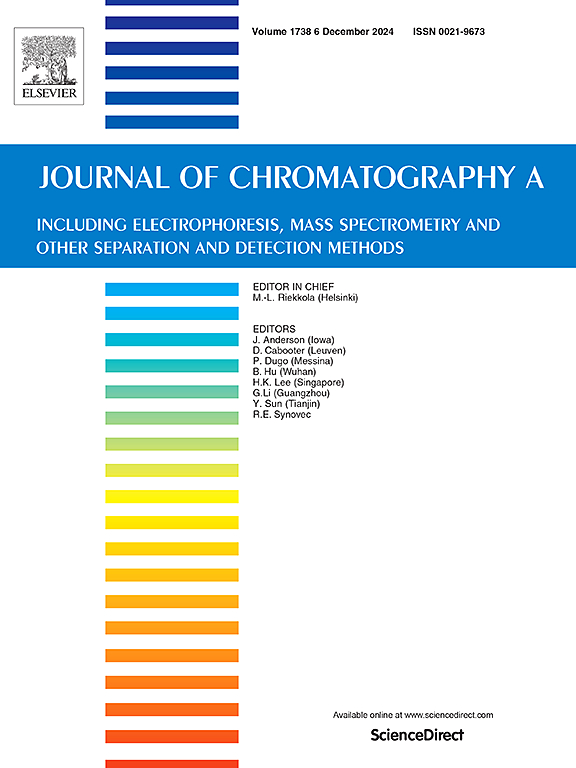羟基化磁微孔有机网络高效磁固相萃取痕量三嗪类除草剂。
IF 3.8
2区 化学
Q1 BIOCHEMICAL RESEARCH METHODS
引用次数: 0
摘要
本文以共价结构构建了丰富的长链羟基功能化磁微孔有机网络(MMON-2OH),用于检测蜂蜜和水样中的8种三嗪类除草剂(THs)。MMON-2OH具有较高的表面积(287.86 m²/g),增强了水相容性,增加了长链羟基的暴露,显著提高了THs的富集能力。理论分析和表征数据揭示了相互作用机制,包括氢键(N- h··O和O- h··N)、卤素键(Cl··N)和π堆叠(NH-π、CH-π和π-π)。该方法用于三手烟的检测,对水的检测限为0.03 ~ 0.6 ng⋅L-1,对蜂蜜的检测限为0.006 ~ 0.134 μg·kg-1。成功检测到地表水中微量浓度为1.0 ~ 21.2 ng·L-1,蜂蜜中微量浓度为0.1 ~ 0.9 μg·kg-1。样品加标回收率在72.1% ~ 116.2%之间,验证了方法的准确性和适用性。本研究实现了对THs的快速、灵敏测定,展示了MMON-2OH在污染物去除和食品安全维护方面的潜力。本文章由计算机程序翻译,如有差异,请以英文原文为准。

Hydroxylated magnetic microporous organic network for efficient magnetic solid phase extraction of trace triazine herbicides
Here we covalently constructed abundant long-chain hydroxyl groups-functionalized magnetic microporous organic networks (MMON-2OH) for detection of eight Triazine herbicides (THs) in honey and water samples. MMON-2OH owned a high surface area (287.86 m²/g), enhanced water compatibility, and increased exposure of long-chain hydroxyl groups, which significantly improved enrichment capacity for THs. Theoretical analyses and characterization data revealed interaction mechanisms, including hydrogen bonds (N-H···O and O-H···N), halogen bond (Cl···N) and π stackings (NH-π, CH-π and π-π). This approach was developed for the detection of THs, achieving a low detection limit 0.03∼0.6 ng⋅L-1 for water, and 0.006∼0.134 μg·kg-1 for honey. Trace concentrations of THs, ranging from 1.0∼21.2 ng⋅L-1 in surface water and 0.1∼0.9 μg·kg-1 in honey, were successfully detected. Sample spiked recovery experiments demonstrated recoveries between 72.1–116.2 %, validating accuracy and applicability of method. This study realizes a speedy and sensitive determination of THs, showcasing potential of MMON-2OH in pollutant removal and food safety maintenance.
求助全文
通过发布文献求助,成功后即可免费获取论文全文。
去求助
来源期刊

Journal of Chromatography A
化学-分析化学
CiteScore
7.90
自引率
14.60%
发文量
742
审稿时长
45 days
期刊介绍:
The Journal of Chromatography A provides a forum for the publication of original research and critical reviews on all aspects of fundamental and applied separation science. The scope of the journal includes chromatography and related techniques, electromigration techniques (e.g. electrophoresis, electrochromatography), hyphenated and other multi-dimensional techniques, sample preparation, and detection methods such as mass spectrometry. Contributions consist mainly of research papers dealing with the theory of separation methods, instrumental developments and analytical and preparative applications of general interest.
 求助内容:
求助内容: 应助结果提醒方式:
应助结果提醒方式:


